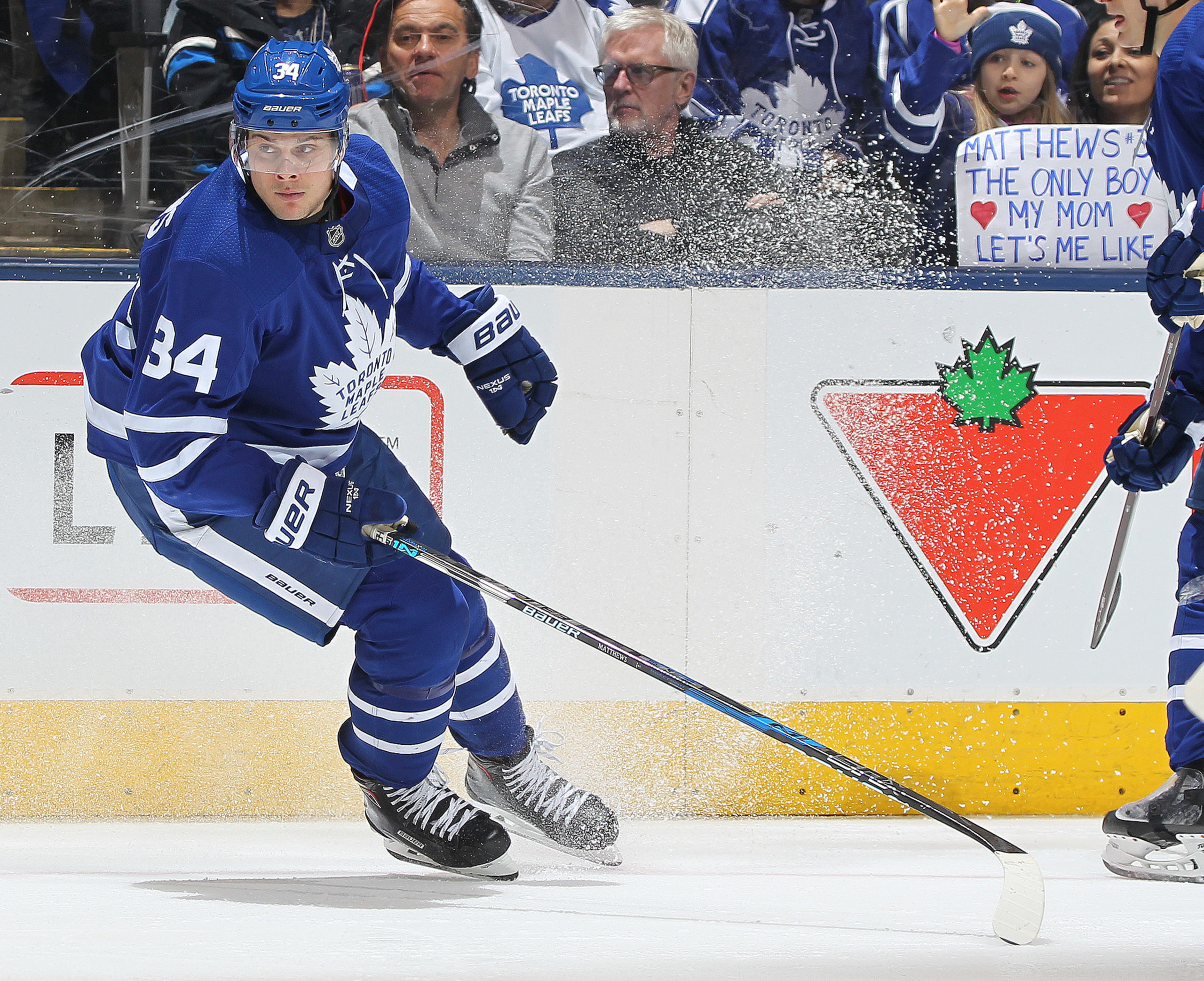For a deal that ensured a legitimate superstar center is going to don a Leafs jersey for the next five and a half years, the final terms of the Auston Matthews contract elicited mixed reactions in Leafs Nation over the past 24 hours.
Let’s get into some initial thoughts and a look at the path forward.
Initial Thoughts on the Deal
I totally understand the concern in some quarters about the final term and AAV of the Auston Matthews contract. I thought Kyle Dubas would get more buy-in on the program he’s selling, and if the deal was only going to be five years in length, I pictured it would be at a more team-friendly amount to make it a little bit easier to keep everyone together.
Part of me wonders whether Brendan Shanahan was just trying to do Dubas a solid in speaking out and talking about discounts last Fall — armed with the strange pre-Cap, big-budget Red Wings team as his example — but part of me also wonders if team-friendly discounts, especially in the feel-good honeymoon phase following the John Tavares victory, was actually built into the Leafs’ cap plan/“Shana-plan”. That’s a big concern, if so, because they clearly aren’t getting any from The Big Three.
But I also think people over-estimate the Leafs‘ leverage in special negotiations like this one with a face-of-the-franchise superstar like Matthews. There is way less room to push the guy around than you might think.
If Matthews’ side says, “This is what we need to make it work for 4 RFA + 1 UFA year, based on what we feel is fair/what we could get via OS or in four years on the open market,” sure, the Leafs can quibble with the structure and shave a little bit off of the AAV, but what are they going to do, ultimately?
This is not a player who is totally unjustified in asking for what he was asking for. He’s a 6’3 centerman who has played his entry-level years at a 40+ goal pace each and every season (almost unheard of), doing most of his damage at 5v5 and driving even-strength (on-ice) scoring chances at a rate matched by no one in the NHL last season.
With a player of Matthews’ stature, you simply cannot trade him or expose him to an offer sheet on July 1. Not much was likely to change, in my opinion, if they waited until April, May, or June to push the deal across the line. If anything, based on what we saw from Matthews this year pre-injury — remember when the headlines were about whether Matthews was better than McDavid, not about the cap catastrophe? — I’m betting Matthews has more to give here after a bit of a mid-season lull.
You may as well get it done now at a rate you can live with and have more clarity going into the trade deadline.
First of Many?
Also at play here is the possibility that the Leafs were essentially first up to bat on what appears to be a shift in thinking around the NHL when it comes to second contracts.
The average age of the league has dropped and so has the number of players driving the bus for their teams within a year or two of breaking the league. Player and agent attitudes are bound to shift along with that new reality.
Now, is it possible Mikko Rantanen, Brayden Point, and Patrik Laine come in at more traditional team-friendly figures on their second contracts, making the Leafs look foolish — like they saw marked-up price tags and assumed the market had shifted, while the other teams proceed to laugh and go along their merry way, signing their high-end young talent to bargain-bin prices? It is possible. We won’t know for a while yet.
It’s possible Rantanen signs a sweetheart deal and says it’s better than eating plain bread three meals a day, a la David Pastrnak, but it’s a lot easier to give the line Pastrnak did when the ink is long since dry on the contract. It’s also quite possible the Lightning get Brayden Point on a great deal — the tax-haven environment in the state of Florida, as well as the culture the Lightning have established, is no doubt enviable, and the latter is something the Leafs were likely hoping they could instill for themselves north of the border.
It’s also worth stating that agents don’t operate in a vacuum. As a community, they know full well the nature of the battles that are on the horizon and the Matthews/Nylander deals are most likely the start of a new order in the NHL.
That said, it’s an unknowable for now, and it will be fascinating to see whether the Leafs are the first of many or the one outlier who misread the landscape.
What Now?
Looking at the 2019-20 cap situation, it is tight to say the least. It was interesting to hear Kyle Dubas point out yesterday that this is when the biggest challenges lie in the near-term Leafs cap outlook. 2019-20 is a real squeeze.
#Leafs 2019-20 Cap situation.
You have 3 spots to fill and can re-sign Marner, Kapanen and Johnsson.
You have at most $12,719,301 to spend. But need a buffer of $500K, so Let's say $12.2M. Let's also say there's no magic wand for Zaitsev and Marleau. What would you do? pic.twitter.com/q74AaFOs5h— Bill Comeau 🏒📊🇨🇦 (@billius27) February 6, 2019
The projection above comes without knowing what the situation is as far as any bonus overages, although it appears the Leafs have budgeted for that this year in their cap calculations. Kasperi Kapanen, Andreas Johnsson, and Garret Sparks are going to need new contracts, and the Leafs will need to fill in a few other holes as well (be it Par Lindholm coming back or the Leafs looking elsewhere).
It also assumes Jake Gardiner walks; that seems like all but a guarantee, but I doubt Kyle Dubas has written off the possibility of him returning entirely yet, especially if he has an inkling he could potentially get out from under the worst contract on the blue line and if there is an appetite on both sides to stretch the term in order to lower the AAV on the Gardiner re-up.
It took only minutes for the media attention and fan anxiety to pivot to Mitch Marner’s situation, with his agent doing his client no favours by giving out interviews about his client’s contract status on the day Matthews signed. I won’t go too far into that here, other than to say the argument that he’s been as valuable to the Leafs as Matthews has been this season (that part is true, in my opinion) and therefore deserves a very similar or matching contract is tinged with recency bias.
Stacking up the ELC production as far as the goal totals, and accounting for the positional difference, he is simply not on par with Matthews. Goal-scorers get paid more and centers get paid more as a fact of life in the NHL. And the difference in overall point production isn’t enough to tip the scales in favour of a matching deal, or even a $10.5-11 million deal, at least in my view. But there is no doubt a high outcome on the Marner extension could turn a tight situation into an undoable one without significant dollars moving out subsequently.
The problem contracts are clear: Nikita Zaitsev’s $4.5 million could arguably be replaced by a $2 million defenseman who could deliver superior results, but whether he could be moved is tough to ascertain at this stage, especially knowing the Leafs certainly can’t retain any salary on the remaining five-year duration of the term.
Patrick Marleau has been written off too soon, in my opinion, but there is no denying the Leafs are paying a premium for his leadership and career accomplishments — not to dismiss the value of the former to this young team — and that the $6.25 million is beyond the value of his production and overall on-ice impact at this stage in his career.
Connor Brown’s impact could likely be delivered for half the price or less by Trevor Moore as soon as next season, so that’s at least one easy move to free up a million and change.
While it’s a big help, the Leafs aren’t in the clear when the Marleau contract comes off the books, obviously; looking further down the road of this six-year window (including this year), Morgan Rielly and Frederik Andersen are vital core pieces who are due up in three and two more years, respectively.
I have no real insights here without an ability to predict the future on Marleau’s plans after this season and the tenability of a Zaitsev trade. But there is no doubt the Leafs are going to have to be ruthlessly efficient on the periphery of their roster — that might involve losing an RFA they’d rather not lose like Johnsson along the way — while continuing to develop young players for the big club at an above-average rate and pace.
Kyle Dubas’ “we can and we will” promise depends on it.


![Sheldon Keefe on the Maple Leafs’ struggling power play: “[We’ve scored] one out of 11 high-danger chances in tight to the net… We have been in those spots and haven’t converted” Sheldon Keefe, playoff press conference](https://mapleleafshotstove.com/wp-content/uploads/2024/04/keefe-pc-game-3-218x150.jpg)

![Jim Montgomery Post Game, Bruins 4 vs. Leafs 2: “[Marchand] still manages to get under people’s skin, yet he doesn’t cross the line” Jim Montgomery, Boston Bruins post game](https://mapleleafshotstove.com/wp-content/uploads/2024/04/jim-monty-pg-to-218x150.jpg)
























![Sheldon Keefe on the Maple Leafs’ struggling power play: “[We’ve scored] one out of 11 high-danger chances in tight to the net… We have been in those spots and haven’t converted” Sheldon Keefe, playoff press conference](https://mapleleafshotstove.com/wp-content/uploads/2024/04/keefe-pc-game-3-100x70.jpg)



![Jim Montgomery Post Game, Bruins 4 vs. Leafs 2: “[Marchand] still manages to get under people’s skin, yet he doesn’t cross the line” Jim Montgomery, Boston Bruins post game](https://mapleleafshotstove.com/wp-content/uploads/2024/04/jim-monty-pg-to-100x70.jpg)

